Experimental Investigation of Lateral Subsurface Flow Depending on Land Use and Soil Cultivation
Abstract
1. Introduction
2. Materials and Methods
2.1. Site Selection and Description
2.2. Experimental Setup
2.3. Data Collection and Analysis
- Beginning, end, duration, and sum of the precipitation event
- Beginning, end, duration, and volume of the individual subsurface flow sections
- Duration between start of precipitation and start of subsurface flow (= response time)
- Precipitation sum and maximum precipitation intensity during the response time
- Shares of flow volumes of sections, segments and levels
3. Results
3.1. Soil Hydraulic Properties
3.2. Framework Conditions of Subsurface Flow Events
3.2.1. Annual Soil Water Budget
3.2.2. Occurrence and Types of Subsurface Flow Events
3.2.3. Impact of Land Use and Topography on Soil Moisture Profiles
3.3. Subsurface Flow Volumes
3.3.1. Impact of the Land Use Type and Topography on Subsurface Flow Volumes
3.3.2. Impact of Season and Soil Cultivation on Subsurface Flow Variability
3.3.3. Impact of Land Use Type on Subsurface Flow Variability
3.4. Response Times of Subsurface Flow Events
3.4.1. Impact of Precipitation Characteristics on Response Times
3.4.2. Heterogeneity of Response Times
4. Discussion
4.1. Impact of Land Use and Soil Management on Soil Hydraulic Properties
4.2. Characteristics of the Framework Conditions of Subsurface Flow Events
4.3. Influencing Factors of Subsurface Flow Magnitudes, Distributions and Response Times
5. Conclusions
Author Contributions
Funding
Acknowledgments
Conflicts of Interest
References
- Beven, K.; Germann, P. Macropores and water flow in soils revisited. Water Resour. Res. 2013, 49, 3071–3092. [Google Scholar] [CrossRef]
- Šanda, M.; Císlerová, M. Transforming Hydrographs in the Hillslope Subsurface. J. Hydrol. Hydromech. 2009, 57. [Google Scholar] [CrossRef]
- Bachmair, S.; Weiler, M. Interactions and connectivity between runoff generation processes of different spatial scales. Hydrol. Process. 2014, 28, 1916–1930. [Google Scholar] [CrossRef]
- Bishop, K.; Seibert, J.; Nyberg, L.; Rodhe, A. Water storage in a till catchment. II: Implications of transmissivity feedback for flow paths and turnover times. Hydrol. Process. 2011, 25, 3950–3959. [Google Scholar] [CrossRef]
- Badoux, A.; Witzig, J.; Germann, P.F.; Kienholz, H.; Lüscher, P.; Weingartner, R.; Hegg, C. Investigations on the runoff generation at the profile and plot scales, Swiss Emmental. Hydrol. Process. 2006, 20, 377–394. [Google Scholar] [CrossRef]
- Burke, A.R.; Kasahara, T. Subsurface lateral flow generation in aspen and conifer-dominated hillslopes of a first order catchment in northern Utah. Hydrol. Process. 2011, 25, 1407–1417. [Google Scholar] [CrossRef]
- Blume, T.; van Meerveld, H.I. From hillslope to stream: Methods to investigate subsurface connectivity. WIREs Water 2015, 2, 177–198. [Google Scholar] [CrossRef]
- Bracken, L.J.; Wainwright, J.; Ali, G.A.; Tetzlaff, D.; Smith, M.W.; Reaney, S.M.; Roy, A.G. Concepts of hydrological connectivity: Research approaches, pathways and future agendas. Earth-Sci. Rev. 2013, 119, 17–34. [Google Scholar] [CrossRef]
- McGlynn, B.L.; McDonnel, J.J.; Brammer, D.D. A review of the evolving perceptual model of hillslope flowpaths at the Maimai catchments, New Zealand. J. Hydrol. 2002, 257, 1–26. [Google Scholar] [CrossRef]
- Woods, R.; Rowe, L. The changing spatial variability of subsurface flow across a hillside. J. Hydrol. 1996, 35, 49–84. [Google Scholar]
- Du, E.; Rhett Jackson, C.; Klaus, J.; McDonnell, J.J.; Griffiths, N.A.; Williamson, M.F.; Greco, J.L.; Bitew, M. Interflow dynamics on a low relief forested hillslope: Lots of fill, little spill. J. Hydrol. 2016, 534, 648–658. [Google Scholar] [CrossRef]
- Freer, J.; McDonnell, J.J.; Beven, K.J.; Peters, N.E.; Burns, D.A.; Hooper, R.P.; Aulenbach, B.; Kendall, C. The role of bedrock topography on subsurface storm flow. Water Resour. Res. 2002, 38. [Google Scholar] [CrossRef]
- Whipkey, R.Z. Subsurface Stormflow on Forested Slopes. Int. Assoc. Sci. Hydrol. Bull. 1965, 10, 74–85. [Google Scholar] [CrossRef]
- Graham, C.B.; Woods, R.A.; McDonnell, J.J. Hillslope threshold response to rainfall: (1) A field based forensic approach. J. Hydrol. 2010, 393, 65–76. [Google Scholar] [CrossRef]
- Zhu, Q.; Lin, H.S. Simulation and validation of concentrated subsurface lateral flow paths in an agricultural landscape. Hydrol. Earth Syst. Sci. 2009, 13, 1503–1518. [Google Scholar] [CrossRef]
- van Schaik, N.; Schnabel, S.; Jetten, V.G. The influence of preferential flow on hillslope hydrology in a semi-arid watershed (in the Spanish Dehesas). Hydrol. Process. 2008, 22, 3844–3855. [Google Scholar] [CrossRef]
- Anderson, A.E.; Weiler, M.; Alila, Y.; Hudson, R.O. Subsurface flow velocities in a hillslope with lateral preferential flow. Water Resour. Res. 2009, 45. [Google Scholar] [CrossRef]
- Noguchi, S.; Tsuboyama, Y.; Sidle, R.C.; Hosoda, I. Subsurface runoff characteristics from a forest hillslope soil profile including macropores, Hitachi Ohta, Japan. Hydrol. Process. 2001, 15, 2131–2149. [Google Scholar] [CrossRef]
- McDonnell, J.J. A rationale for old water discharge through macropores in a steep, humid catchment. Water Resour. Res. 1990, 26, 2821–2832. [Google Scholar] [CrossRef]
- Gonzalez-Sosa, E.; Braud, I.; Dehotin, J.; Lassabatère, L.; Angulo-Jaramillo, R.; Lagouy, M.; Branger, F.; Jacqueminet, C.; Kermadi, S.; Michel, K. Impact of land use on the hydraulic properties of the topsoil in a small French catchment. Hydrol. Process. 2010, 18. [Google Scholar] [CrossRef]
- Rieger, W. Prozessorientierte Modellierung Dezentraler Hochwasserschutzmaßnahmen. Ph.D. Thesis, Universität der Bundeswehr, Neubiberg, Germany, 2012. [Google Scholar]
- Jost, G.; Schume, H.; Hager, H.; Markart, G.; Kohl, B. A hillslope scale comparison of tree species influence on soil moisture dynamics and runoff processes during intense rainfall. J. Hydrol. 2012, 420–421, 112–124. [Google Scholar] [CrossRef]
- Fiener, P.; Auerswald, K.; van Oost, K. Spatio-temporal patterns in land use and management affecting surface runoff response of agricultural catchments—A review. Earth-Sci. Rev. 2011, 106, 92–104. [Google Scholar] [CrossRef]
- Bodner, G.; Scholl, P.; Loiskandl, W.; Kaul, H.-P. Environmental and management influences on temporal variability of near saturated soil hydraulic properties. Geoderma 2013, 204–205, 120–129. [Google Scholar] [CrossRef] [PubMed]
- Kargas, G.; Kerkides, P.; Sotirakoglou, K.; Poulovassilis, A. Temporal variability of surface soil hydraulic properties under various tillage systems. Soil Till. Res. 2016, 158, 22–31. [Google Scholar] [CrossRef]
- Holland, J.M. The environmental consequences of adopting conservation tillage in Europe: Reviewing the evidence. Agric. Ecosyst. Environ. 2004, 103, 1–25. [Google Scholar] [CrossRef]
- Tebrügge, F.; Düring, R.-A. Reducing tillage intensity—A review of results from a long-term study in Germany. Soil Till. Res. 1999, 53, 15–28. [Google Scholar] [CrossRef]
- Leys, A.; Govers, G.; Gillijns, K.; Berckmoes, E.; Takken, I. Scale effects on runoff and erosion losses from arable land under conservation and conventional tillage: The role of residue cover. J. Hydrol. 2010, 390, 143–154. [Google Scholar] [CrossRef]
- Saffarpour, S.; Western, A.W.; Adams, R.; McDonnell, J.J. Multiple runoff processes and multiple thresholds control agricultural runoff generation. Hydrol. Earth Syst. Sci. 2016, 20, 4525–4545. [Google Scholar] [CrossRef]
- Hopp, L.; McDonnell, J.J. Connectivity at the hillslope scale: Identifying interactions between storm size, bedrock permeability, slope angle and soil depth. J. Hydrol. 2009, 376, 378–391. [Google Scholar] [CrossRef]
- BGL. Geologische Übersichtskarte 1:500.000 Bayern, 4th ed.; Bayerisches Geologisches Landesamt: München, Germany, 1996. (In German) [Google Scholar]
- BGR. Hydrogeologische Übersichtskarte 1:200000 von Deutschland (HÜK200). Oberer Grundwasserleiter—CC 8734 Rosenheim; Bundesanstalt für Geowissenschaften und Rohstoffe: Hannover, Germany, 2011. (In German) [Google Scholar]
- LfU. Weiß-blaues Klima. Available online: http://www.lfu.bayern.de/wasser/klima_wandel/bayern/index.htm (accessed on 9 March 2015). (In German).
- LfL. Wetterstation Dürabuch (LfL): Vieljähriges Mittel DWD Maisach. Available online: http://www.am.rlp.de/Internet/AM/NotesBAM.nsf/bamweb/286b2f1c437d83b3c1257392004329af?OpenDocument (accessed on 22 December 2018). (In German).
- LfU. Digitale Übersichtsbodenkarte von Bayern im Maßstab 1:25000. ÜBK25; Bayerisches Landesamt für Umwelt: Augsburg, Germany, 2013. (In German) [Google Scholar]
- OTT Hydromet GmbH. Orpeus Mini. Technische Daten. 2019. Available online: https://www.ott.com/de-de/produkte/wasserstand-49/ott-orpheus-mini-61/productAction/outputAsPdf/ (accessed on 13 January 2019).
- Davis Instruments. Rain Collector Data Sheet. 2013. Available online: https://www.davisinstruments.com/product_documents/weather/spec_sheets/7857-7852_SS.pdf (accessed on 12 March 2019).
- Davis Instruments. Anemometer Data Sheet. 2013. Available online: https://www.davisinstruments.com/product_documents/weather/spec_sheets/6410_SS.pdf (accessed on 12 March 2019).
- Davis Instruments. Solar Radiation Sensor Data Sheet. 2010. Available online: https://www.davisinstruments.com/product_documents/weather/spec_sheets/6450_SS.pdf (accessed on 12 March 2019).
- Davis Instruments. External Temperature/Humidity Data Sheet. 2006. Available online: https://www.davisinstruments.com/product_documents/weather/spec_sheets/7859_spec_Rev_D.pdf (accessed on 12 March 2019).
- UGT. SMT-100 Datenblatt. Messung des Volumetrischen Wassergehaltes. 2015. Available online: https://www.ugt-online.de/fileadmin/Public/downloads/Produkte/Bodenkunde/Bodenfeuchte/SMT-100_Datenblatt_de.pdf (accessed on 12 March 2019).
- DECAGON. 5TE—Water Content, EC and Temperature Sensor; Data Sheet; Decagon Devices: Pullman, WA, USA, 2016. [Google Scholar]
- DECAGON. 5TM—Water Content and Temperature Sensors; Data Sheet; Decagon Devices: Pullman, WA, USA, 2016. [Google Scholar]
- UGT. Tensio 152 Datenblatt. 2014. Available online: https://www.ugt-online.de/fileadmin/Public/downloads/Produkte/Bodenkunde/Tensiometer/Tensio_152.pdf (accessed on 12 March 2019).
- Cytron Technologies. HC-SR04 Ultrasonic Sensor. User’s Manual. 2013. Available online: http://www.fonteniaud.fr/COURS/ELECTRONIQUE%20GMP2/TITRE%2000-COURS/01--THEORIE/prof/datasheet/HCSR04.2.pdf (accessed on 12 March 2019).
- Maxim Integrated. DS18B20. Programmable Resolution 1-Wire Digital Thermometer. 2018. Available online: https://datasheets.maximintegrated.com/en/ds/DS18B20.pdf (accessed on 13 January 2019).
- Weiler, M.; Naef, F. An experimental tracer study of the role of macropores in infiltration in grassland soils. Hydrol. Process. 2003, 17, 477–493. [Google Scholar] [CrossRef]
- Heller, H.; Teschemacher, S. Internet of Things: Moderne Technik für die Umweltdatenerfassung. In Workshop UIS; Arbeitskreis Umweltinformationssysteme: Nürnberg, Germany, 2018. [Google Scholar]
- UGT. ku-pf Apparatur. Bedienungsanleitung. Version: 19/08/11. 2011. Available online: https://www.ugt-online.de/fileadmin/Public/downloads/Produkte/Bodenkunde/Leitfaehigkeit/ku-pF.pdf (accessed on 12 March 2019).
- Amoozegar, A. A Compact Constant-Head Permeameter for Measuring Saturated Hydraulic Conductivity of the Vadose Zone. Soil Sci. Soc. Am. J. 1989, 53, 1356. [Google Scholar] [CrossRef]
- Schwartz, R.C.; Evett, S.R.; Unger, P.W. Soil hydraulic properties of cropland compared with reestablished and native grassland. Geoderma 2003, 116, 47–60. [Google Scholar] [CrossRef]
- Graham, C.B.; McDonnell, J.J. Hillslope threshold response to rainfall: (2) Development and use of a macroscale model. J. Hydrol. 2010, 393, 77–93. [Google Scholar] [CrossRef]
- Klaus, J.; Jackson, C.R. Interflow Is Not Binary: A Continuous Shallow Perched Layer Does Not Imply Continuous Connectivity. Water Resour. Res. 2018, 54, 5921–5932. [Google Scholar] [CrossRef]
- Adhikari, K.; Hartemink, A.E. Linking soils to ecosystem services—A global review. Geoderma 2016, 262, 101–111. [Google Scholar] [CrossRef]
- Gissi, E.; Gaglio, M.; Aschonitis, V.G.; Fano, E.A.; Reho, M. Soil-related ecosystem services trade-off analysis for sustainable biodiesel production. Biomass Bioenergy 2018, 114, 83–99. [Google Scholar] [CrossRef]
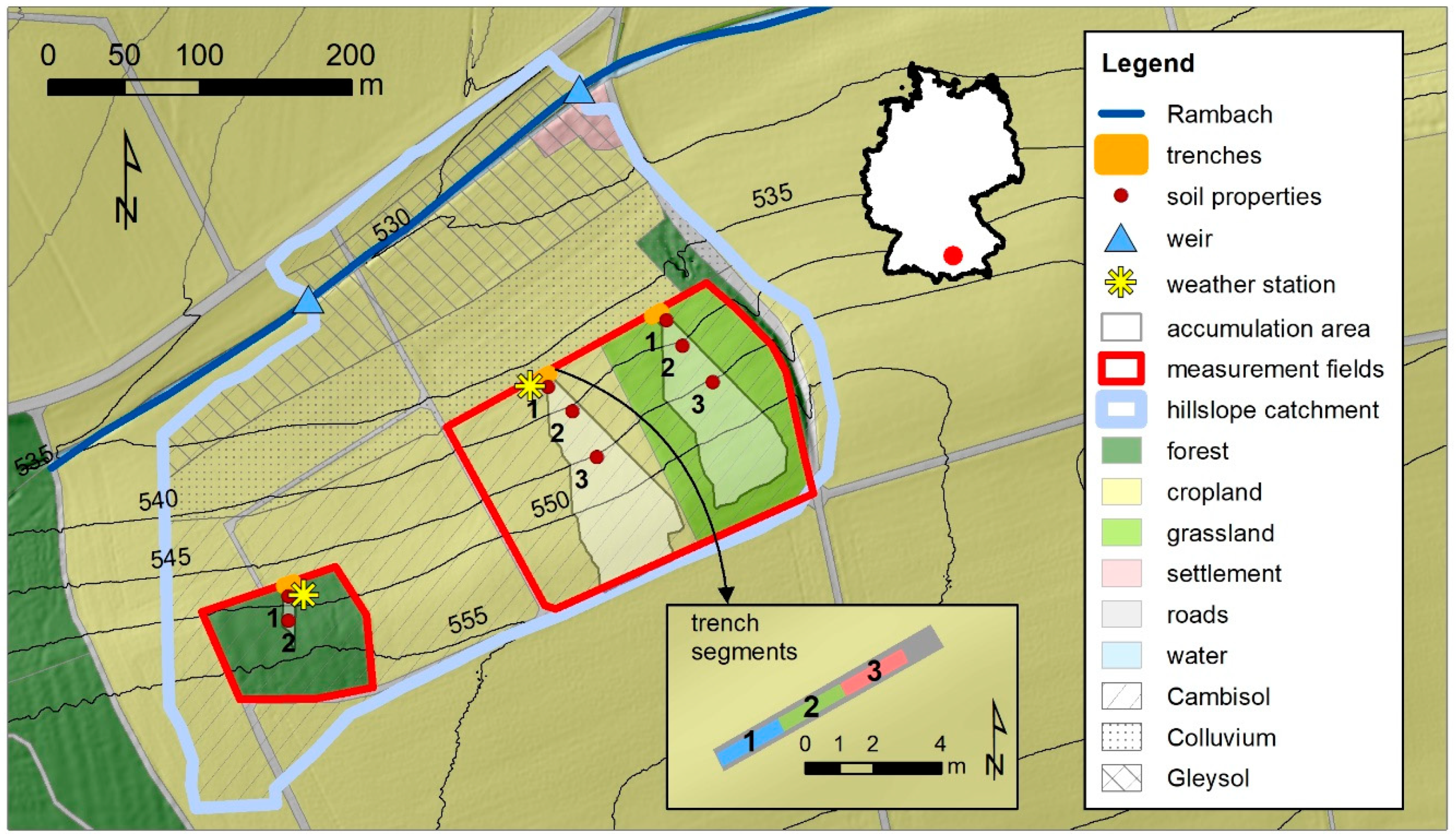
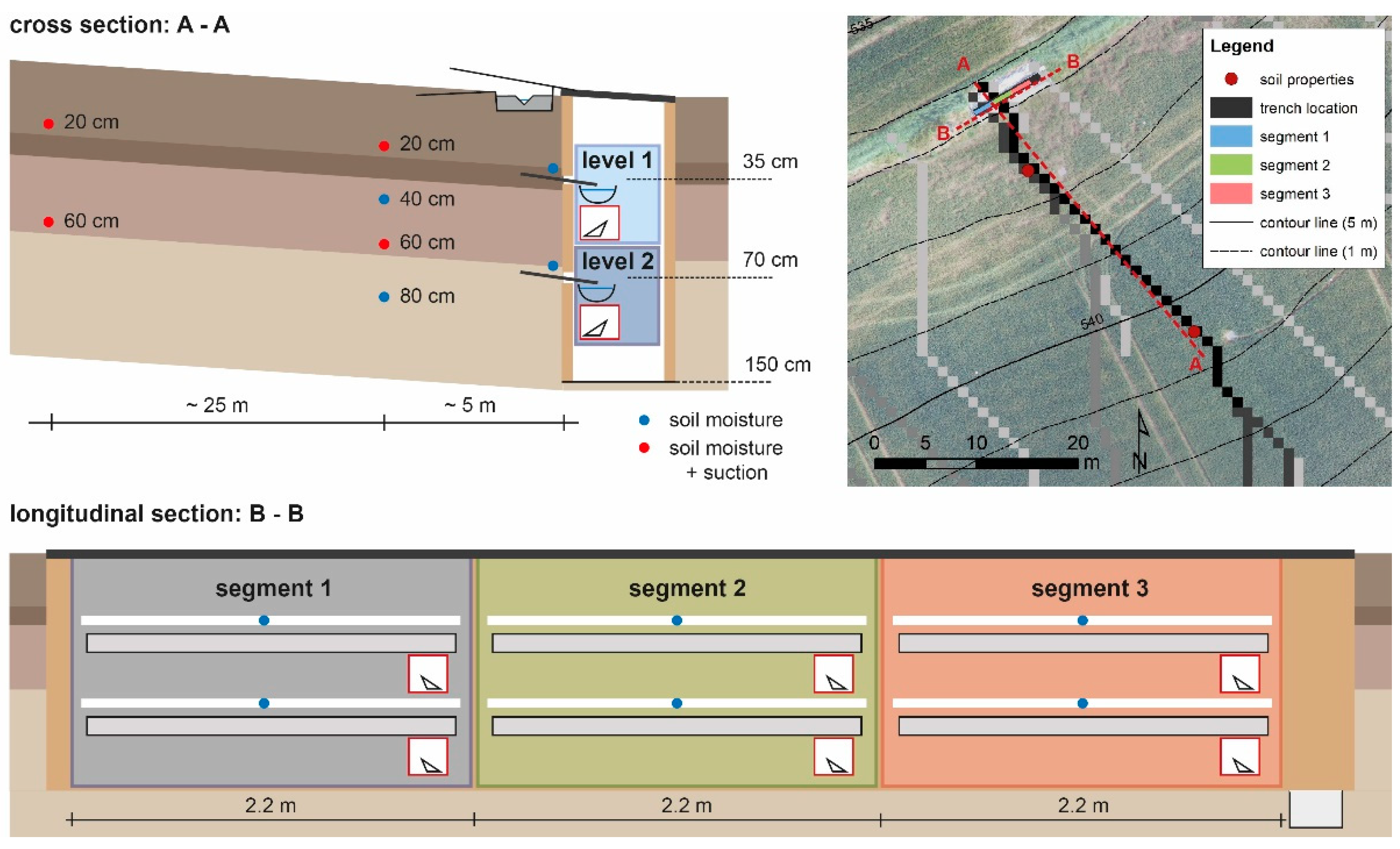
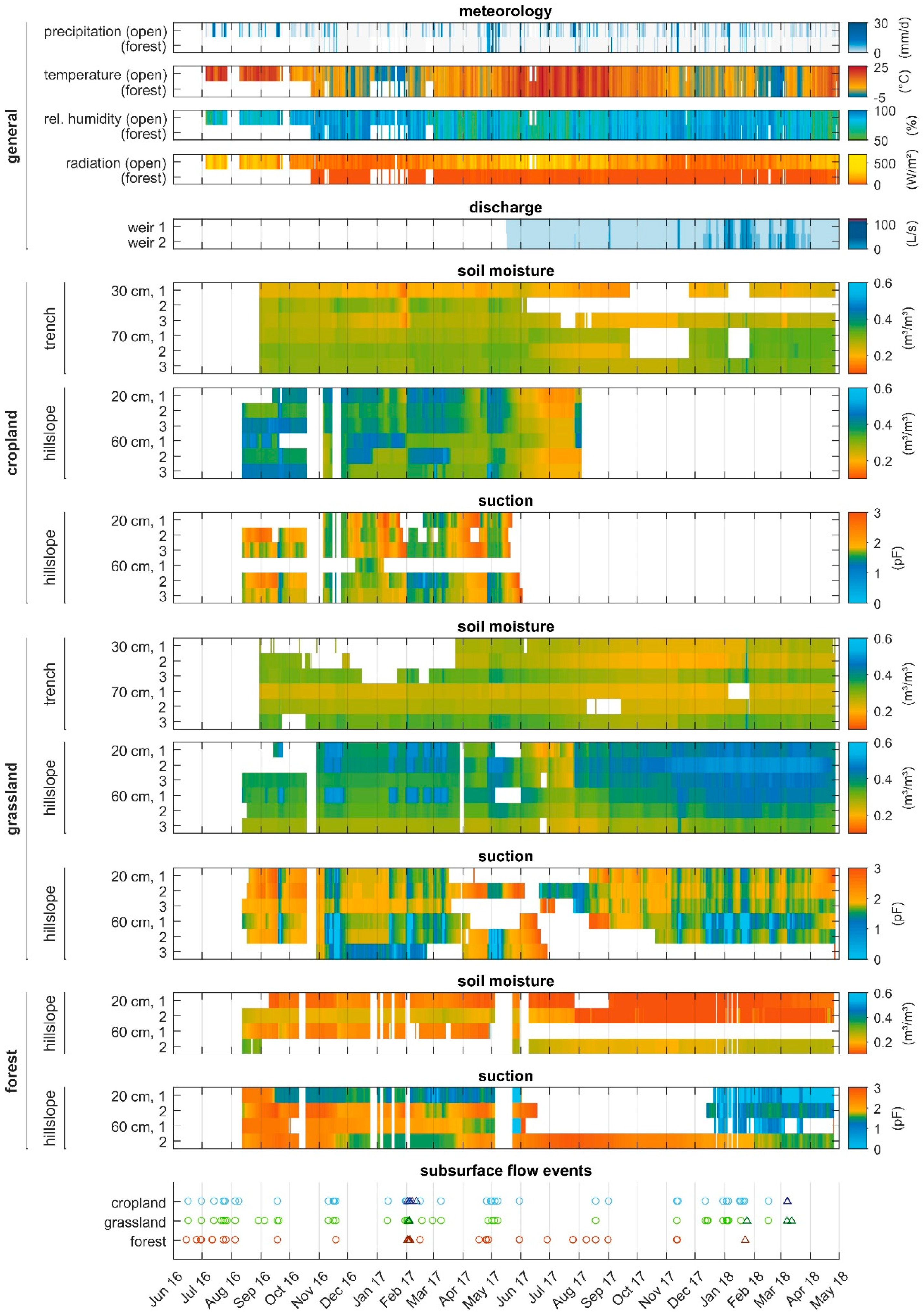
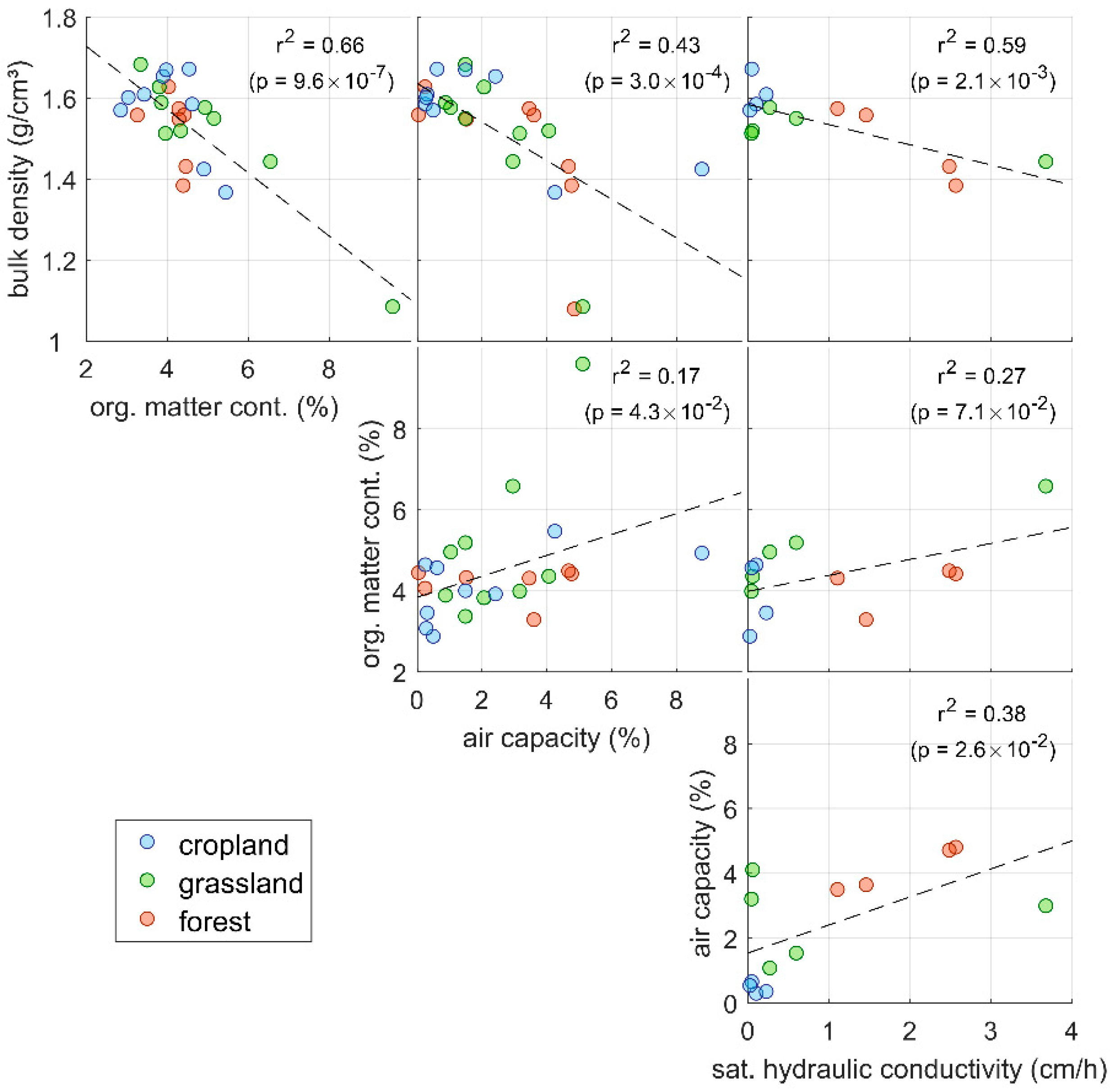

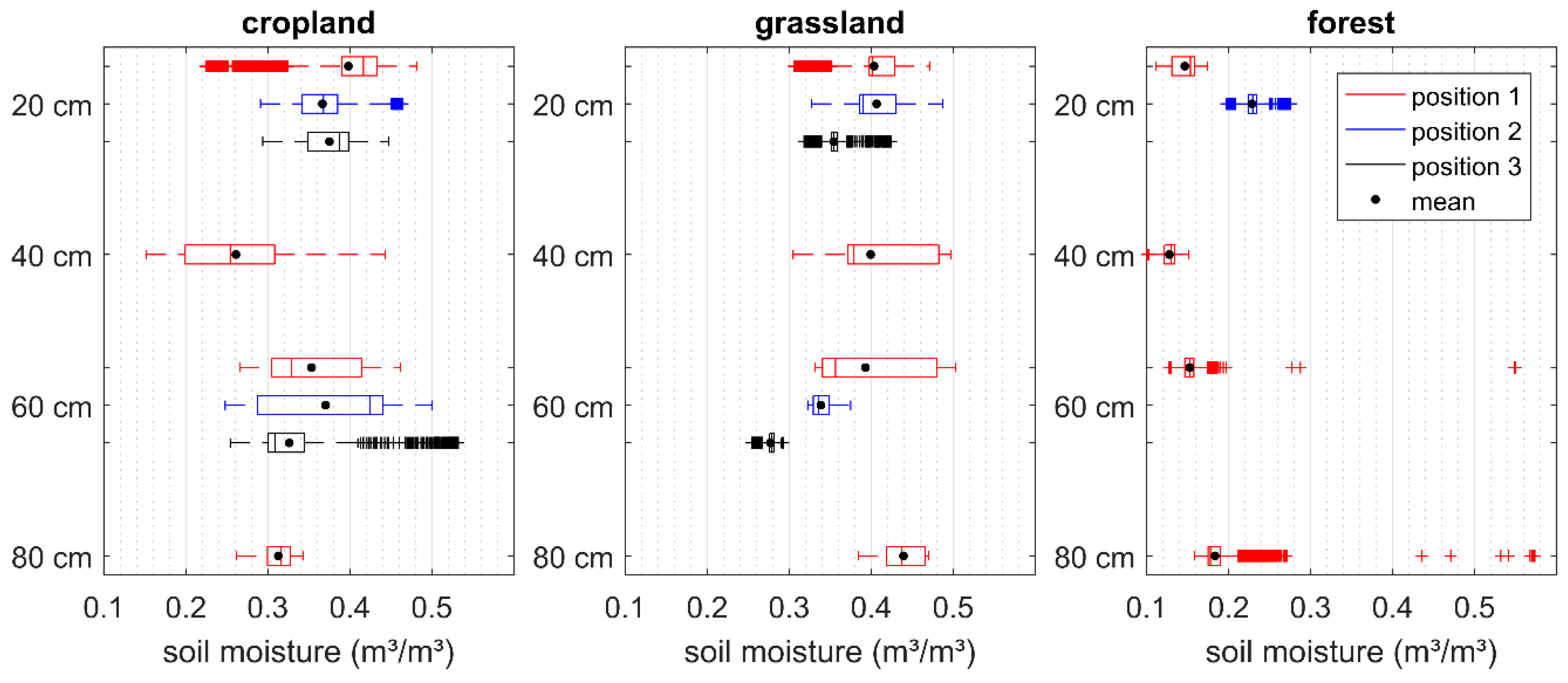
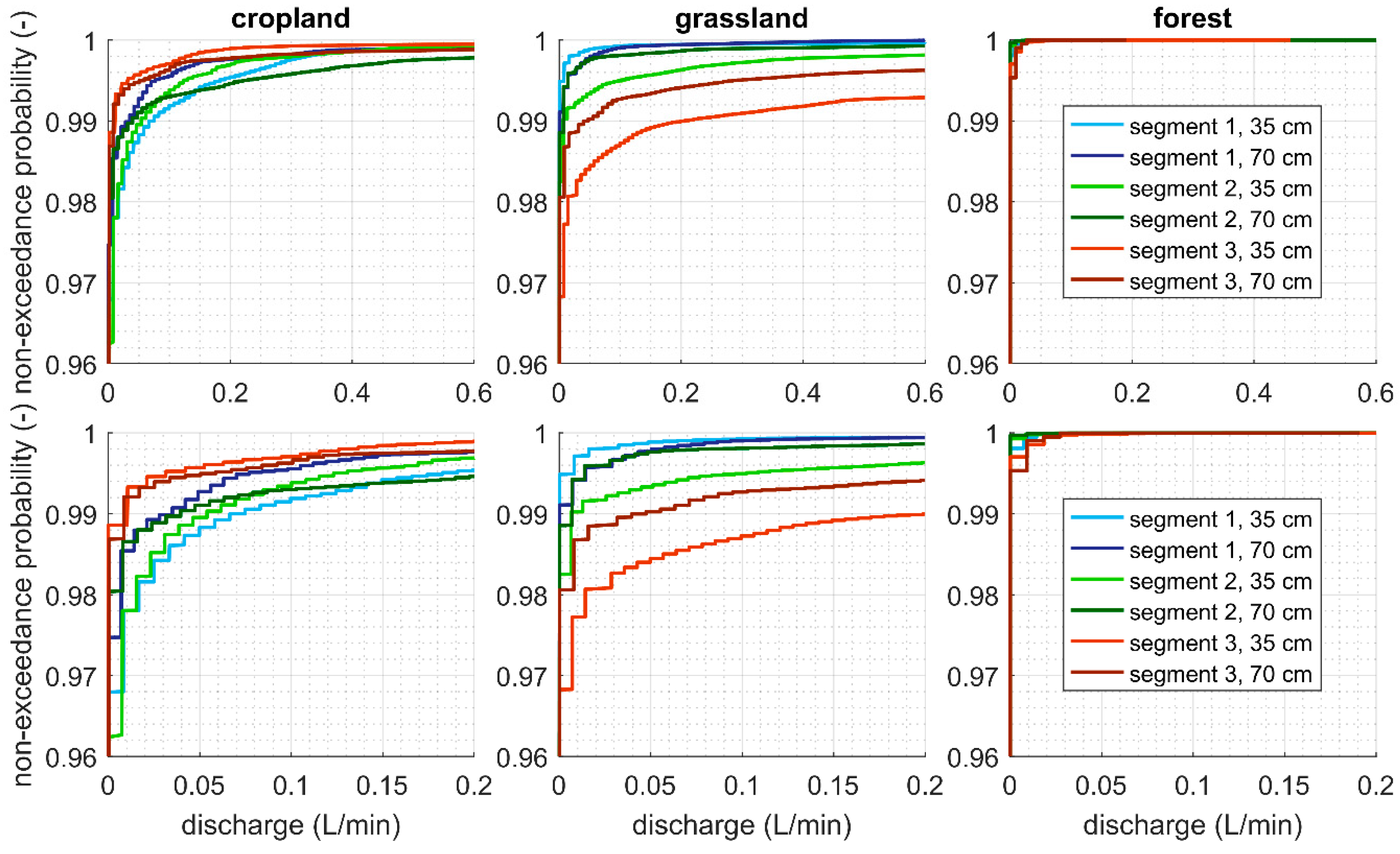
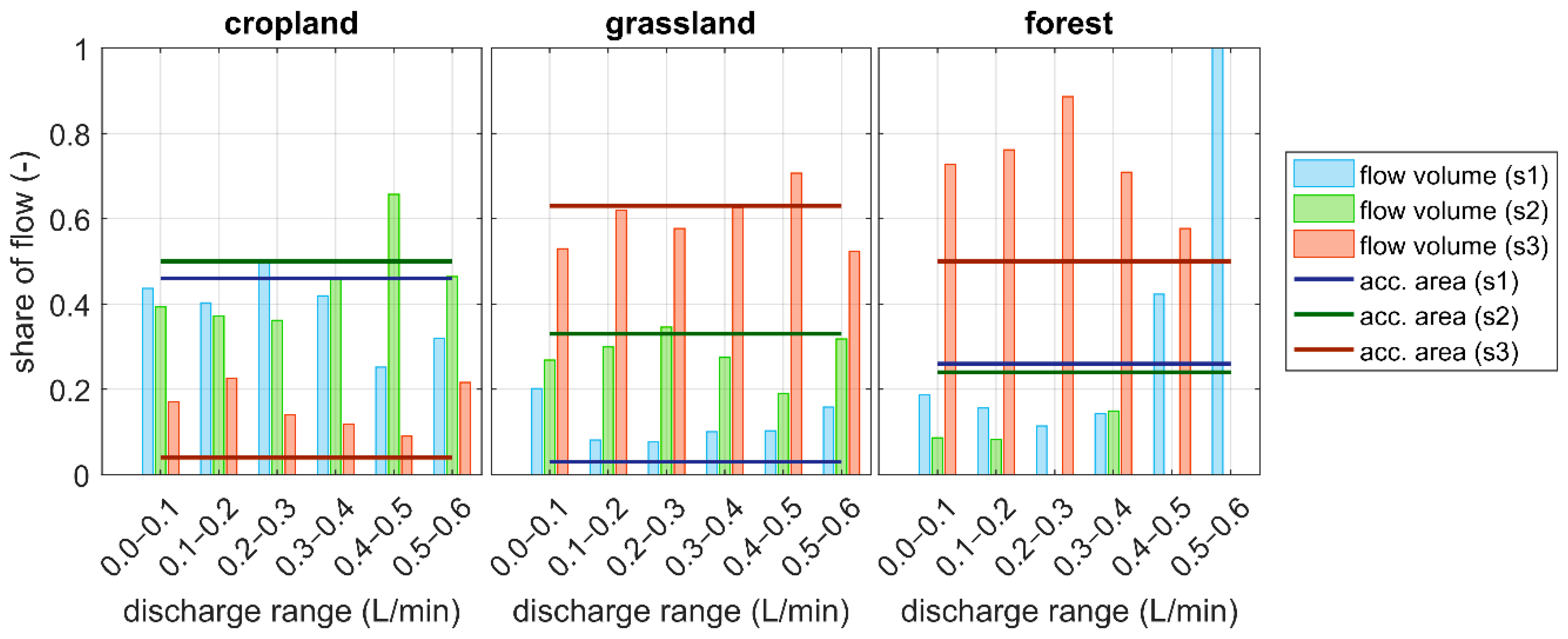

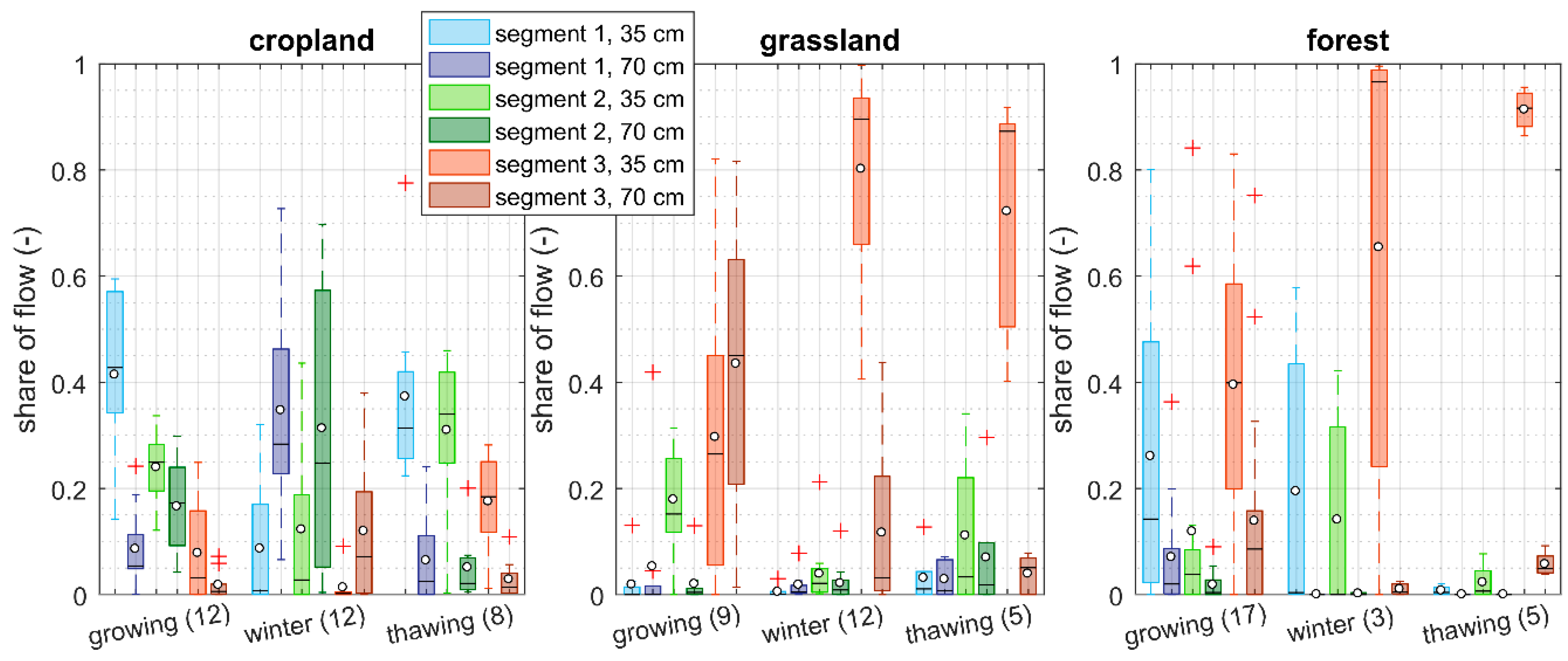
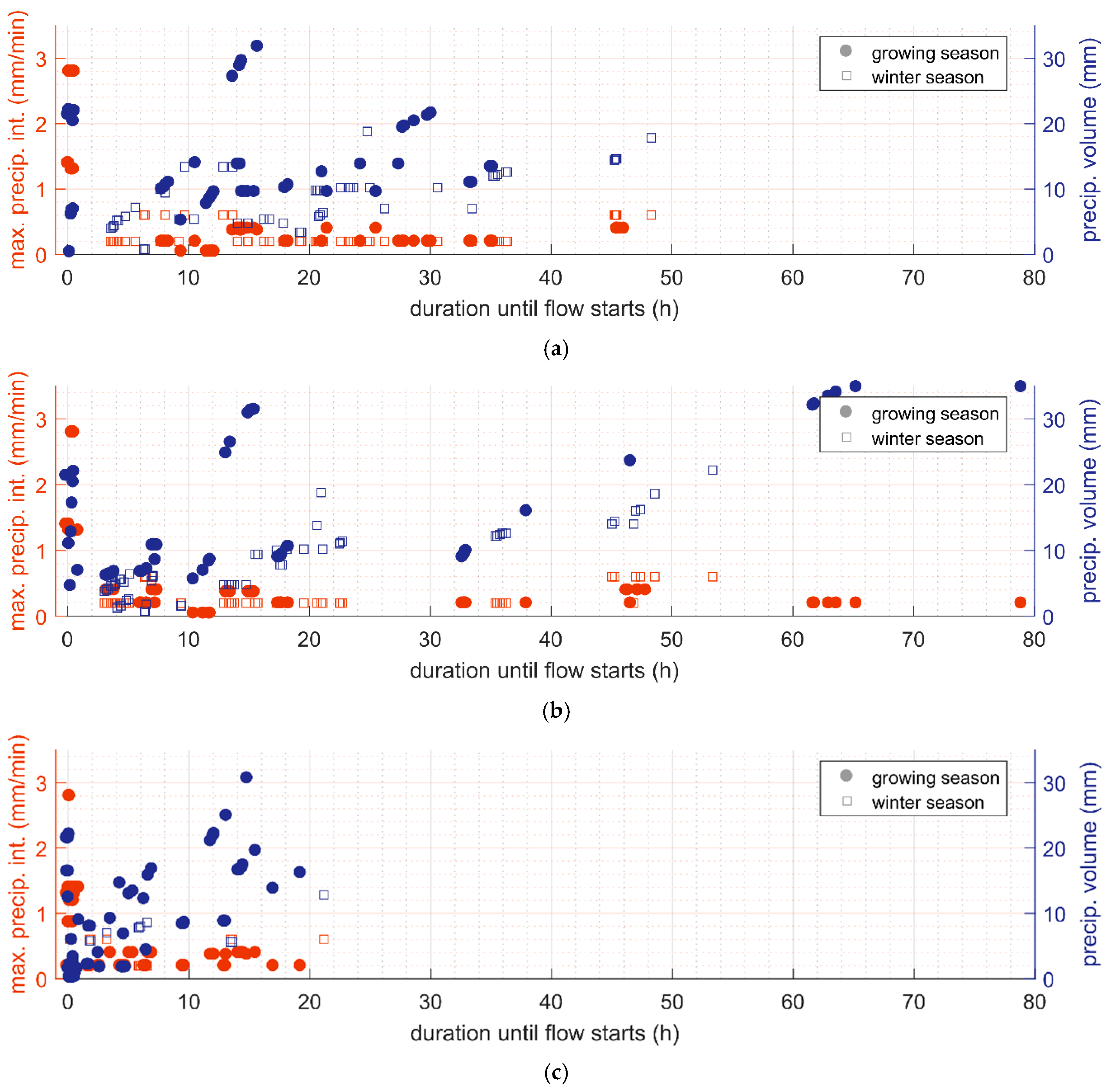

| Land Use Type | Cropland | Grassland | Forest |
|---|---|---|---|
| Elevation | 537 m.a.s.l. | 537 m.a.s.l. | 547 m.a.s.l. |
| Slope angle (mean/max) | 11.4%/29.4% | 11.7%/20.0% | 18.7%/27.2% |
| Slope length | 146 m | 132 m | 46 m |
| Accumulation area | 6076 m² | 5133 m² | 273 m² |
| Accumulation in segment 1 | 0.46 (-) | 0.03 (-) | 0.26 (-) |
| Accumulation in segment 2 | 0.50 (-) | 0.33 (-) | 0.24 (-) |
| Accumulation in segment 3 | 0.04 (-) | 0.63 (-) | 0.50 (-) |
| Land Use | Depth | Sand Content | Silt Content | Clay Content | Bulk Density (g/cm³) | Org. Matter Content | Air Capacity | Available Water Capacity | Sat. Hydraulic Conductivity (cm/h) | |
|---|---|---|---|---|---|---|---|---|---|---|
| Before Harv. | After Harv. | |||||||||
| cropland | 0–20 | 25.77% ± 2.20% (3) | 45.48% ± 0.36% (3) | 28.74% ± 2.52% (3) | 1.39 ± 0.12 (21) | 5.28% ± 0.31% (6) | 2.49% ± 2.74% (9) | 26.71% ± 8.47% (9) | 0.84 (2) | - |
| 20–40 | 26.2% ± 2.77% (3) | 49.09% ± 1.09% (3) | 24.71% ± 3.85% (3) | 1.62 ± 0.09 (19) | 4.58% ± 0.33% (6) | 0.50% ± 0.04% (7) | 28.23% ± 5.10% (7) | 1.29 ± 0.52 (3) | 0.07 ± 0.04 (3) | |
| 40–60 | 22.17% (2) | 40.90% (2) | 36.93% (2) | 1.63 ± 0.06 (12) | 3.68% ± 0.29% (4) | 1.28% ± 1.71% (5) | 22.76% ± 5.97% (5) | 1.42 (2) | 0.23 (2) | |
| 60–100 | 29.15% (1) | 52.26% (1) | 18.59% (1) | 1.61 ± 0.08 (18) | 3.39% ± 0.55% (6) | 0.91% ± 0.81% (6) | 15.15% ± 2.22% (6) | 0.11 ± 0.18 (4) | 0.03 (1) | |
| grassland | 0–20 | 21.90% ± 2.04% (3) | 47.51% ± 4.63% (3) | 30.58% ± 2.80% (3) | 1.25 ± 0.21 (24) | 7.57% ± 1.64% (6) | 2.15% ± 1.30% (7) | 24.69% ± 4.02% (7) | 3.68 ± 2.84 (3) | |
| 20–40 | 18.68% (2) | 50.38% (2) | 30.94% (2) | 1.57 ± 0.08 (23) | 5.06% ± 0.25% (4) | 2.62% ± 1.58% (7) | 22.15% ± 6.20% (7) | 0.42 ± 0.33 (7) | ||
| 40–60 | 15.84% (2) | 50.05% (2) | 34.11% (2) | 1.54 ± 0.10 (15) | 4.11% ± 0.36% (4) | 2.27% ± 1.45% (5) | 21.24% ± 3.80% (5) | 0.07 (1) | ||
| 60–100 | 15.06% (1) | 51.45% (1) | 33.48% (1) | 1.61 ± 0.13 (27) | 3.71% ± 0.44% (6) | 1.74% ± 0.46% (5) | 17.36% ± 1.18% (5) | 0.05 ± 0.04 (3) | ||
| forest | 0–20 | 26.19% (2) | 48.21% (2) | 25.61% (2) | 1.24 ± 0.19 (21) | 4.41% ± 0.27% (4) | 4.74% ± 2.11% (7) | 20.81% ± 3.61% (7) | 2.57 (1) | |
| 20–40 | 26.67% ± 8.00% (3) | 41.89% ± 4.29% (3) | 31.44% ± 4.34% (3) | 1.48 ± 0.13 (20) | 3.68% ± 0.63% (6) | 3.56% ± 2.62% (7) | 20.22% ± 3.00% (7) | 1.81 ± 0.97 (3) | ||
| 40–60 | 26.23% (1) | 42.43% (1) | 31.34% (1) | 1.57 ± 0.04 (6) | 4.30% (2) | 0.26% ± 0.18% (3) | 27.26% ± 1.38% (3) | 0.89 ± 0.38 (3) | ||
| 60–100 | 23.88% (1) | 51.87% (1) | 24.25% (1) | 1.58 ± 0.05 (9) | 4.26% ± 0.24% (6) | 0.94% ± 0.97% (5) | 22.59% ± 3.26% (5) | - | ||
© 2019 by the authors. Licensee MDPI, Basel, Switzerland. This article is an open access article distributed under the terms and conditions of the Creative Commons Attribution (CC BY) license (http://creativecommons.org/licenses/by/4.0/).
Share and Cite
Teschemacher, S.; Rieger, W.; Disse, M. Experimental Investigation of Lateral Subsurface Flow Depending on Land Use and Soil Cultivation. Water 2019, 11, 766. https://doi.org/10.3390/w11040766
Teschemacher S, Rieger W, Disse M. Experimental Investigation of Lateral Subsurface Flow Depending on Land Use and Soil Cultivation. Water. 2019; 11(4):766. https://doi.org/10.3390/w11040766
Chicago/Turabian StyleTeschemacher, Sonja, Wolfgang Rieger, and Markus Disse. 2019. "Experimental Investigation of Lateral Subsurface Flow Depending on Land Use and Soil Cultivation" Water 11, no. 4: 766. https://doi.org/10.3390/w11040766
APA StyleTeschemacher, S., Rieger, W., & Disse, M. (2019). Experimental Investigation of Lateral Subsurface Flow Depending on Land Use and Soil Cultivation. Water, 11(4), 766. https://doi.org/10.3390/w11040766






